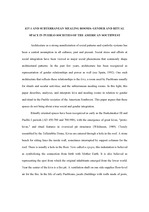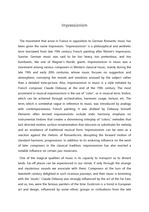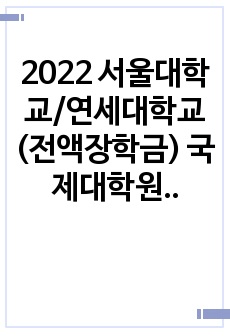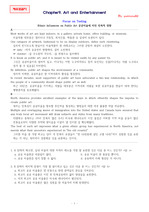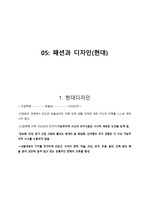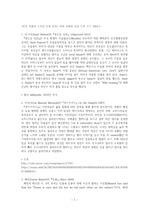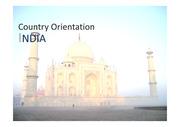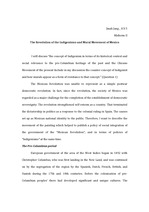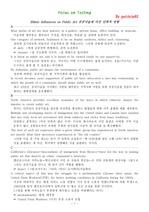

-
미리보기
소개
영어로 쓰여져 있는 Ethnic Arts에 대한 리포트 입니다.목차
없음본문내용
Architecture as a strong manifestation of social patterns and symbolic systems has been a central assumption in all cultures, past and present. Social stress and efforts at social integration have been viewed as major social phenomena that commonly shape architectural patterns. In the past few years, architecture has been recognized as representation of gender relationships and power as well (see Spain, 1992). One such architecture that reflects these relationships is the kiva, a room used by Puebloans usually for rituals and secular activities, and the subterranean mealing rooms. In this light, this paper describes, analyzes, and interprets kiva and mealing rooms in relation to gender and ritual in the Pueblo societies of the American Southwest. This paper argues that these spaces do not bring about a true social and gender integration.
Ritually oriented spaces have been recognized as early as the Basketmaker III and Pueblo I periods (AD 450-700 and 700-900), with the emergence of great kivas, "proto-kivas," and ritual features in oversized pit structures (Wilshusen, 1989). Closely resembled by the Telletubbie Dome, Kivas are entered through a hole in the roof. A stone bench for sitting lines the inside wall, sometimes interrupted by support columns for the roof. There is usually a hole in the floor. Now called a sipapu, this indentation is believed as symbolizing the connection from birth with Mother Earth. It is also believed as representing the spot from which the original inhabitants emerged from the lower world. Near the center of the kiva is a fire pit. A ventilation shaft on one side supplies floor-level air for the fire. In the life of early Puebloans, jacals (buildings with walls made of posts, sometimes covered with adobe and rock facings) or masonry surface storage structures were built in addition to traditional pithouse lodges and semisubterranean kivas.참고자료
· Babcock, B. A. (1990). At Home No Womens Are Storytellers: Potteries, Stories and Politics in Cochiti Pueblo. Journal of the Southwest, 32, 356-389.
· Charles, N. and Kern, M. (1988). Women, Food and Families. New York: Manchester University Press.
· Cordell, L. S. (1994). Ancient Pueblo Peoples. Washington D.C.: St. Remy Press.
· Cordell, L. S. (1997). Archeology of the Southwest. New York: Academic Press.
· Dozier, E. P. (1965) Southwestern Social Units and Archaeology. American Antiquity, 31, 38-47.태그
-
자료후기
Ai 리뷰지식판매자의 자료를 통해 새로운 인사이트를 얻을 수 있었습니다. 주제가 흥미롭고, 내용이 충실해 많은 도움이 되었습니다. 추천할 만한 자료입니다! 감사합니다! -
자주묻는질문의 답변을 확인해 주세요

꼭 알아주세요
-
자료의 정보 및 내용의 진실성에 대하여 해피캠퍼스는 보증하지 않으며, 해당 정보 및 게시물 저작권과 기타 법적 책임은 자료 등록자에게 있습니다.
자료 및 게시물 내용의 불법적 이용, 무단 전재∙배포는 금지되어 있습니다.
저작권침해, 명예훼손 등 분쟁 요소 발견 시 고객센터의 저작권침해 신고센터를 이용해 주시기 바랍니다. -
해피캠퍼스는 구매자와 판매자 모두가 만족하는 서비스가 되도록 노력하고 있으며, 아래의 4가지 자료환불 조건을 꼭 확인해주시기 바랍니다.
파일오류 중복자료 저작권 없음 설명과 실제 내용 불일치 파일의 다운로드가 제대로 되지 않거나 파일형식에 맞는 프로그램으로 정상 작동하지 않는 경우 다른 자료와 70% 이상 내용이 일치하는 경우 (중복임을 확인할 수 있는 근거 필요함) 인터넷의 다른 사이트, 연구기관, 학교, 서적 등의 자료를 도용한 경우 자료의 설명과 실제 자료의 내용이 일치하지 않는 경우
함께 구매한 자료도 확인해 보세요!
-
[영어작문] A Journey into Art 8페이지
When I was a kid I didn’t realize that the stars were always in the sky, whether it was night or day mattered little to me, I thought that like most kids my age that stars didn’t exist during the day... -
[예술]전시공강 14페이지
전시란, 흥미ㅡ 주의 관심을 끌기 위하여 어떤 공간내에 존재하는 상품의 구성과 연출이라는 전달 수단을 통하여 상품의 강한 이미지나 주제를 적극적으로 전달, 설명하는 일체의 의도적인 행위를 말한다. 따라서 단지 나영된 상태이거나 자연 현상을 보는 상태는 진정한 전시의 의미가 없다고 하겠다. 전시를 의미하는 용어로는 Display, Exposition, exh.. -
[영문 감상평]천경자의 혼 7페이지
Chun Kyung-ja in Korean Comtemporary Art. In last April, the Gallery Hyundai held a special exhibition for Chun Kyung-ja even though she is alive in New York. In many cases, a special exhibition o.. -
미술전시회를 다녀와서-Sobral Centeno 5페이지
지난 8일 친구와함께 다녀온 청담동의 MICHAEL SCHULTZ라는 갤러리에는 한 포르투갈 작가의 개인전이 진행중이었다. 인터넷 서핑을 하던 중에 어떤 싸이트에서 우연히 보게된 그의 작품이 마음에 들어 그날 곧바로 찾아간 것이다. Sobral Centeno라는 이름의 그는 1948년 포르투갈 출신으로 Porto 미술대학교에서 수학하였다고 나와있는데, 이밖.. -
영문으로 쓴 artistic monuments of the High Italian Renaissance 2페이지
The Age of Pericles refers to the period in Greek history that spans from the Persian Wars in 448 BCE to the death of Pericles 429 BCE or the Peloponnesian War in 404 BCE. Pericles was an Athenian ge..
찾으시던 자료가 아닌가요?
지금 보는 자료와 연관되어 있어요!
문서 초안을 생성해주는 EasyAI
